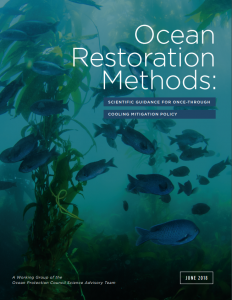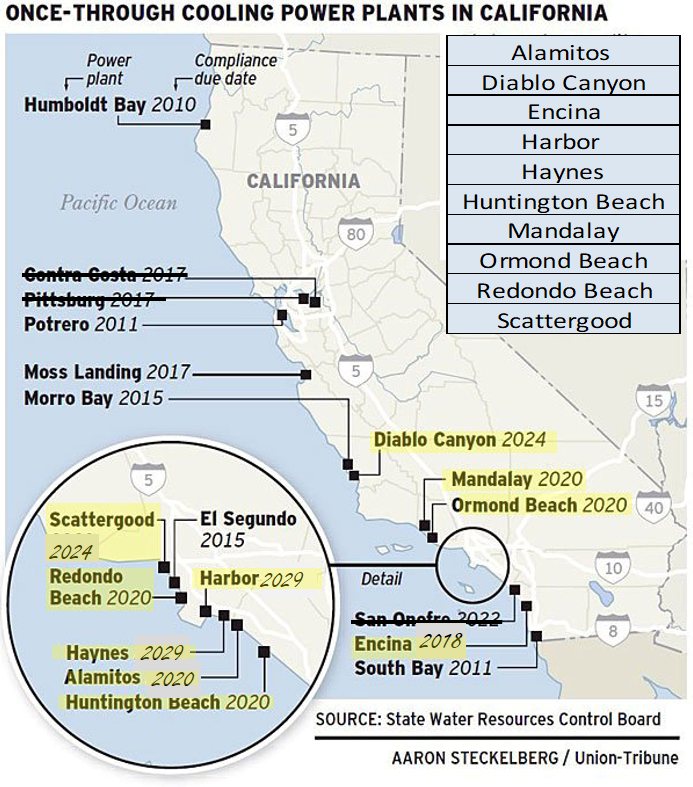Once-Through Cooling Interim Mitigation Program
Request for Proposals
Future funding solicitations will be announced on this website and through our email announcements. Sign up to receive OPC emails.
Award Guidelines
Once-Through Cooling Interim Mitigation Program (Program) funds can be distributed through two funding mechanisms: 1) a competitive award program, and 2) discretionary awards, including but not limited to interagency contracts and other projects addressing timely or emerging problems. The Program’s Award Guidelines establish the high-level process and criteria that OPC will use to solicit competitive applications, evaluate and select proposals, and distribute awards. As Program priorities and the amount of interim mitigation funds received may change from year to year, the competitive solicitation released each year will provide more specific details on the types of projects OPC is soliciting and the amount of funding available. Program priorities are defined in Section 1.2.

Ocean Restoration Methods
The Ocean Protection Council Science Advisory Team (OPC-SAT) released a report in June 2018 entitled “Ocean Restoration Methods: Scientific Guidance for Once-Through Cooling Mitigation Policy”. This report provides essential guidance on the scientific principles needed to identify restoration projects that meaningfully offset the impacts of once-through cooling.
A Working Group of the OPC-SAT, convened by the Ocean Science Trust, applied the best science available to help identify an ecological framework that would allow the evaluation of projects that would have a high likelihood of meeting the requirements of the Policy to increase marine life associated with California’s MPA network. Their findings determined that due to oceanographic currents connecting locations both inside and outside of MPAs, harmful effects of once-through cooling extends hundreds of kilometers from a power plant’s intake pipe. Given the geographic extent of power plants still using once-through cooling, the findings of this report define the areas impacted as the entirety of State waters (3 nautical miles from the coastline) from San Diego to Big Sur coast (near Lucia), including the waters around the Channel Islands.
Program Background

Once-through cooling (OTC) technology pulls water from the ocean to cool power plants. Marine animals, seaweeds, and billions of eggs and larvae of fish and invertebrates are taken in with the seawater and killed as they are subjected to thermal, physical, and/or chemical stresses. Larger organisms may also be pinned against seawater intake screens, causing injury or death. These impacts contribute to the decline of fisheries and the degradation of marine habitats near power plants using once-through cooling.
To address these damaging impacts, the State Water Resources Control Board established a Once-Through Cooling Policy (Policy) in 2010 requiring power plants to stop using once-through cooling technology. The Policy originally applied to 19 coastal power plants (including two nuclear plants) that had the ability to withdraw over 15 billion gallons per day from the State’s coastal and estuarine waters using OTC systems. Closed-cycle wet cooling has been selected as Best Technology Available and permittees must either reduce intake flow and velocity or reduce impacts to aquatic life comparably by other means. The Policy requires power plants that are not in compliance to make mitigation payments annually based on their annual intake volume of water until they come into compliance. To ensure grid reliability, final compliance dates were negotiated with each of the plants listed on the map after the name of each power plant (right). Through closures of older plants, denoted by strike-through on the map, and retrofits to come into compliance prior to the payment program beginning, there are now 10 power plants that will be making payments until they come into compliance (highlighted in yellow). OPC will receive up to $5.4 million annually from these mitigation payments to fund to its OTC Interim Mitigation Program. Funds will decrease as power plants come into compliance with the Policy, and the Program is expected to end in 2029 when all power plants are required to be in compliance.
The policy gives a clear directive that funds received through this program will support “mitigation projects directed toward increases in marine life associated with the state’s marine protected areas in the geographic region of the facility”. To further implement the Policy and build out the OTC Interim Mitigation Program, OPC entered into a Memorandum of Understanding with the State Water Resources Control Board that allocates $5.4 million of the annual payments to mitigate the impacts of OTC on state MPAs. The allotment amount was based on an interagency budget analysis conducted by the MPA Statewide Leadership Team of costs associated with the MPA Management Program that have a direct nexus with OTC impacts.
The Ocean Protection Council’s Once-Through Cooling Interim Mitigation Program directs mitigation payments to support the four priorities of the MPA Management Program:
- Enforcement of MPA regulations statewide
- Outreach and education to improve compliance of MPA regulations statewide
- Research to establish and quantify the expected ecological benefits of the MPA Network and
understand what additional mitigation may be required to offset OTC impacts - Restoration that increases marine life in the geographic region of OTC facilities
For more information, see the Policy and Science Framework Linking California’s Marine Protected Area Network to OTC Impacts.
Visit the State Water Resources Control Board Cooling Water Intake Structures Once-Through Cooling Water Policy – Interim Mitigation Measures webpage for more information on interim mitigation payment requirements and annual reports from the OPC and State Coastal Conservancy.
Staff Contact

Staci Lewis
Marine Protected Areas
Program Manager
Staci.Lewis@resources.ca.gov

